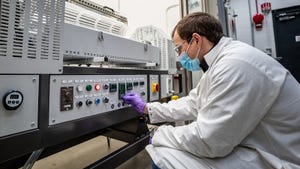Celebrating EVs & Their Batteries—Then & Now
See the history of the electric vehicle displayed and discussed at the birthplace of the Model T in Detroit.
August 21, 2023

Scarcely five minutes from Factory Zero, GM’s ultramodern dedicated EV assembly complex, lies another Detroit industrial landmark: 416 Piquette Avenue is Henry Ford’s first factory and the birthplace of the Model T (and B, C, and F, among others). Built in 1904 and acquired in 2000 by the nonprofit Model T Automotive Heritage Complex Inc., extensive renovation and restoration efforts have ensued and continue today. Placed on the National Register of Historic Places in 2002, it now operates as a museum and educational center.
Known as the Ford Piquette Avenue Plant (FPAP), the museum recently showcased selected antique electric vehicles from its collection and contributors, and conducted panel discussions with automotive historians and current battery and electric vehicle industry principals as part of its exhibit “EVs: Then and Now,” July 28-30.
Batteries included
Friday, July 28, was “Under the Hood Day,” with antique EV owners on hand to explain the charm and operating aspects of their vehicles. Included on the display floor was a set of two Gould 5-cell lead-acid batteries that would have been part of 14 batteries (seven in the front and seven in the rear) used for powering a 1914 Detroit Electric. The Gould Storage Battery Works Corp. of Depew, NY, went on to notably expand its battery business, including supplying submarine batteries to the US Navy during World War II.
Quick history quiz question: Circa 1899–1914, who was the largest EV producer in the world? That would be Baker Motor Vehicle Co. (Cleveland, OH). Baker Electrics were elegant and marketed at society women such as First Lady Helen Taft (an owner). The coupes advertised full weather protection and an operating range of 80 to 100 miles of metropolitan excursions per charge.
Another highlight on the display floor also had a specific marketing target. The 1907 Juvenile Electric Runabout was marketed at children, specifically rich children. At $800 in 1907 (approximately $26,000 in today’s dollars), then as now it was more expensive than a number of full-sized passenger cars. Powered by six batteries (12-volt cells), it had two forward and two reverse speeds and could reach 20 miles on a single charge.
Our electric future
EVs yesterday, today, and tomorrow took the stage at FPAP on Sunday, July 30, in the form of two presentations. Television and print journalist Carol Cain interviewed Matt Anderson, curator of transportation at The Henry Ford (a Dearborn, MI, museum complex) on EV history. Anderson noted that famous friends Henry Ford and Thomas Edison had many discussions and subsequent car designs for testing their battery tech. He added that purchase price, among other factors, was a factor in the eventual dominance of the internal-combustion-engine-powered Model T at approximately $550 versus $1500 for a comparably sized electric.
Cain also performed moderator duties for a panel discussion on current EV business and developments, Panelists were Dave Pericak, director of EV truck programs for Ford Motor Co.; Michael Tercheck, e-mobility OEM sales director at Freudenberg Sealing Technologies; Pina Vyas, business transformation leader for DTE Energy; and Mujeeb Ijaz, founder and CEO of battery maker Our Next Energy (ONE).
Ford’s Pericak highlighted the achievements Ford was making in serving the high demand for the F-150 Lightning all-electric pickup. A recent six-week shutdown for expansion and retooling at the Ford Rouge Electric Vehicle Center in Dearborn has been completed with the aim of more than tripling annual units produced from 45,000 to 150,000 this year.
As a whole, the panel agreed on the critical nature of new innovations, such as DTE’s “grid of the future,” Freudenberg’s custom seals and vibration controls, and ONE’s range-anxiety-eliminating 600-mile-range LFP (lithium iron phosphate) batteries. From the turn of the previous century to the reaches of the foreseeable future, batteries and vehicle electrification are inspiring history-making events.
Visit the Ford Piquette Avenue Plant yourself and be inspired. Meanwhile, click below to see 16 highlights. More information at FordPiquettePlant.org.
About the Author(s)
You May Also Like





